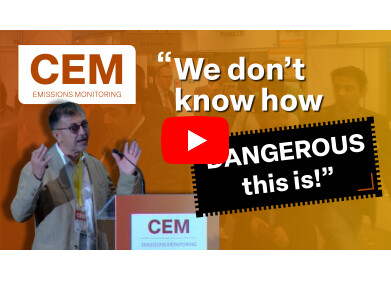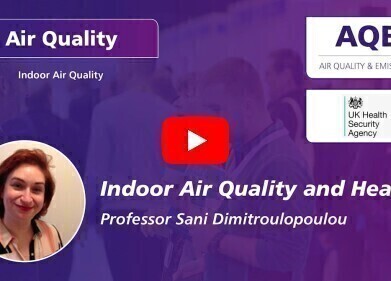Indoor air quality monitoring (IAQ)
The Challenges Ahead for Air Monitoring in 2022
Jan 05 2022
For almost two decades, eyebrows have been steadily raising over at the World Health Organisation. Year after year, air pollution kept ascending the ranks of global threats to health. Now, after setting out new guidelines for air quality, the United Nations’ agency puts it on par with poor diet and tobacco.
Clearly, then, the stakes are high. But as we weather yet another global spike in COVID-19 cases, it already feels like 2022 will be just more of the same. So, if the environmental monitoring community are going to make this a genuinely new year for air quality, there are three challenges they’ll need to address.
Regulation
As climatologists, nutritionists and cardiologists know all too well, it’s often difficult to get governments to take emerging scientific understanding seriously, especially if the research looks, on first glance, like it was written by Chicken Little. But even though the predictions are worryingly gloomy, government intervention is a necessary part of reversing the apocalyptic trends.
As it stands, the United Kingdom is in two minds; Downing Street and Holyrood have chosen diverging paths.
In England, the newly-minted Environment Act of 2021 leaves much to be desired. For a start, it does not update national limits on PM2.5 or nitrogen oxides, the two most harmful pollutants in ambient air. Such limits are four times the World Health Organisation’s recommendations. Even worse, perhaps, is the fact that the Act fails to introduce caps for short-term (24-hour) exposure – another drastic discordance with the WHO.
In fact, the only provisions made for air quality targets in the Act are the deadlines it sets for secondary legislation; by October, the English parliament must have decided upon a new annual mean for PM2.5, as well as one other target.
This is the window of opportunity. It is a period of time in which a great many Ministers can be persuaded of decisive action on air quality - and arguments for the political advantage of such measures may, as always, be the most dependable.
As the only viable opponent to the Scottish Nationalist Party’s total domination of Holyrood, the Conservatives may need an ambitious air quality agenda if they are to increase their share of seats. For the Scottish Nationalists have shown themselves to be, quite frankly, world-leaders in air quality legislation. Indeed, their latest programme, Cleaner Air for Scotland 2, which passed into law a matter of months before the Environment Act, cuts an aspirational figure. It makes Scotland the first European nation to write the World Health Organisation’s guidelines on PM2.5 into domestic legislation – a striking contrast to English ambitions – and pledges funding for the construction of a national monitoring network to enforce these new limits.
At the moment, then, it’s hard to tell whether the glass is half-full or half-empty. But as has already been suggested, the current state of affairs offers appealing opportunities if the air monitoring community is willing to play at politics. Indeed, it may be a unique chance to solve the problem of regulation in 2022.
Indoor Air Quality
As a result of the COVID-19 pandemic, indoor living, which was already at historic levels, has become both mandatory and customary. At the same time, the public has been forced to absorb the fact that air is a major vector for pathogens. All of which, as we have recently reported, has made employees eager for improvements in air quality. Together, these pressures make indoor air quality an urgent concern in 2022.
These pressures have led to a renewed interest in airborne epidemiology, the science of air’s role in promoting disease. Greater attention has been paid to the sources of indoor airborne pollutants and pathogens, which are, on the whole, communicated to indoor environments rather than cultivated by them. These new considerations have sparked debates about methods of mitigation which have produced a rough consensus in favour of filtration over ventilation.
In 2022, broader consensuses must be established, and greater understanding must inform more effective action. For instance, the standardisation of a ‘transmissibility index’ for air is an imminent possibility as our knowledge of the conditions for pathogen transmission through air deepens. It is hoped that such a tool will enhance the efficacy and nuance of regulation. Time will tell.
Climate Change
Ongoing ecological break-down has re-focused the air quality agenda. Often, actions that decelerate global warming double by necessity as air quality controls – think decarbonisation or deindustrialisation. Similarly, the climate crisis has forced governments into global cooperation, establishing institutions with the capability and the jurisdiction needed to deal with transnational problems like air pollution.
That being said, of course, a focus on climate change can obstruct air quality targets, and it cannot be assumed that all measures which stabilise or lower planetary temperatures have the same effect on air pollution. For instance, retrofitting a biomass boiler into every primary school in the country may drastically reduce Britain’s contribution to global warming but it would expose one of our most vulnerable populations to higher levels of dioxins and furans, two of the most harmful persistent organic pollutants. Threatening devasting disruptions to the endocrine and immune systems of the exposed, it certainly seems too great a risk, even considering the potentially catastrophic result of higher average temperatures.
If 2022 is going to be a landmark year in air quality, the environmental monitoring community must take advantage of international institutions to ensure that the accumulating will for action on the climate crisis does not unnecessarily jeopardise air quality and therefore, global health.
For news and updates on air quality, stay tuned to Envirotech Online. If you’d like to know more or be more involved in the air quality community, consider attending our annual Air Quality and Emissions event, which features presentations and panel discussions from leading researchers, industry experts and thought leaders.
Digital Edition
AET 28.4 Oct/Nov 2024
November 2024
Gas Detection - Go from lagging to leading: why investment in gas detection makes sense Air Monitoring - Swirl and vortex meters will aid green hydrogen production - Beyond the Stack: Emi...
View all digital editions
Events
Jan 12 2025 Abu Dhabi, UAE
Jan 14 2025 Abu Dhabi, UAE
Jan 20 2025 San Diego, CA, USA
Carrefour des Gestions Locales de L'eau
Jan 22 2025 Rennes, France
Safety, Health & Wellbeing LIVE
Jan 22 2025 Manchester, UK



















